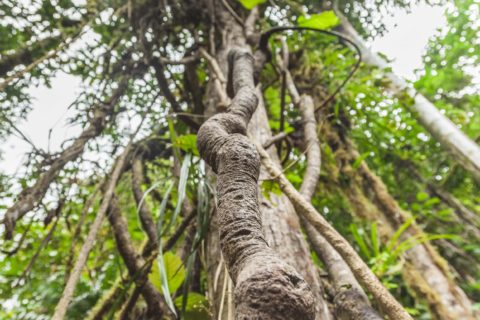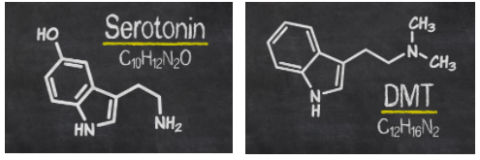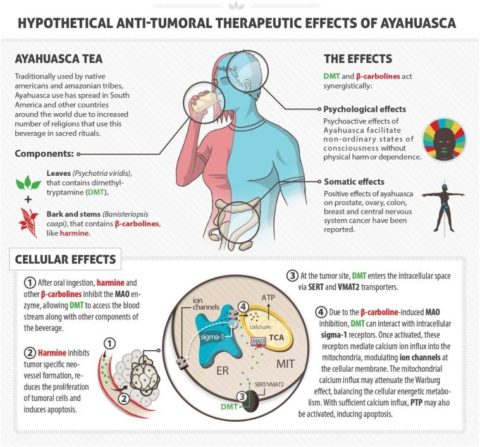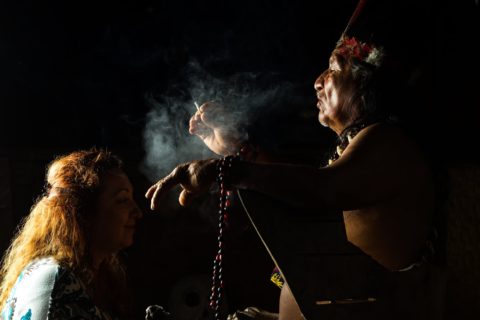
Ayahuasca is a psychoactive brew from the deep Amazon. It’s said to stimulate the senses, alter mental states, and change the perception of reality. Ayahuasca retreats have recently become popular worldwide, but many people overlook the dangers that undergoing a ceremony can place them in. What does the science say? Read on to learn more about this controversial drink.
Disclaimer: DMT, an ingredient in Ayahuasca brews, is classified as a Schedule I substance. This means that it is an illegal drug with high potential for harm and no known medical uses. We highly advise against the use of DMT-containing Ayahuasca brews until future studies determine their safety and efficacy in medically-supervised and safe settings. The only aim of this post is to outline risks and research findings.
What Is Ayahuasca?
How Much Do We Know?
Ayahuasca – a chemically complex brew that exerts many psychoactive effects on users. Amazonian folk medicine claims it can enhance emotions and deep introspection and purge the body. Allegedly, shamans have been occasionally using it for spiritual purposes since pre-colonial times.
Modern science wants to understand if it can help people with mental health issues, but ayahuasca research has regulatory barriers and needs to be carefully performed because of possible side effects.
However, we know little about its impact on human health, and clinical trials are currently underway.
There are physiological and psychological risks associated with its use. Until proper safety and effectiveness trials are carried out, Ayahuasca brews will remain potentially dangerous and illegal. Thus, we currently recommend against taking them.
Historical Use
Ayahuasca (or hoasca) is a psychoactive brew made from two hallucinogenic plants (Banisteriopsis caapi and Psychotria viridis). Traditionally, this brew is used by the natives of South America for its hallucinogenic properties in their spiritual and cultural practices [1].
The brew is traditionally made by boiling the bark and stems of the two plants (Banisteriopsis caapi and Psychotria viridis) [2].
Archeological evidence suggests that the earliest use of ayahuasca was more than four thousand years ago [3].
In the 20th century, the popularity of ayahuasca began spreading around the world because of globalization and religious tourism [4].
Spiritual & Cultural Background
Essentially, ayahuasca is a hallucinogenic blend that causes psychedelic effects. Indigenous people claim that it can trigger unique out-of-body experiences. These are sometimes described as spiritual journeys that deliver some sort of advice to the users. Thus, it was strongly associated with shamanism [5].
The ayahuasca-induced state of mind is said to allow shamans to enter a trance state and hallucinate [5].
Ayahuasca has a strong religious and cultural background. It’s also been an intriguing literary topic.
The McKenna brothers wrote about ayahuasca in their book True Hallucinations. Aldous Huxley wrote about mescaline and other hallucinogenic plants in The Doors of Perception: Heaven and Hell. Plus, most people have heard of Don Juan’s (likely fictional) psychedelic journeys in Castaneda’s works (see The Teachings of Don Juan).
However, all these shamanism-related claims mostly remain outside the realm of science.
Legal Status
Despite having cultural significance, the legality of ayahuasca is a controversial issue.
Although ayahuasca plants and preparations are legal in the US, their status is unclear. Specifically, these plants are legal since they contain no illicit chemicals. However, brews made using DMT-containing plants are illegal since DMT is a Schedule I drug [6, 7].
The U.S. Supreme Court has ruled in favor of using ayahuasca plants for religious purposes under the Religious Freedom Restoration Act of 1993 [8].
Ayahuasca is also in the FDA’s poisonous plants database [9].
How Is Ayahuasca Proposed to Work?
The ayahuasca brew contains varying concentrations of psychedelic drugs (DMT and MAO inhibiting harmala alkaloids), depending on the batch. These psychedelic drugs seem to work in tandem to exert effects on the brain.
The preparation creates an altered state of mind. Users are reported to experience introspective properties such as visions, the recollection of previous memories, and vivid emotions [10].
The ayahuasca brew contains harmine and harmaline, which appear to inhibit MAO-A (Monoamine oxidase-A) in the gut. MAO-A is an enzyme that breaks down certain chemicals and neurotransmitters (serotonin, DMT, dopamine) [11].
DMT and serotonin have similar structures.
DMT (N, N-Dimethyltryptamine) is a potent chemical found in many different plant species. It has a similar molecular structure to serotonin and can also be degraded by MAO-A.
Scientists found that the inhibition of MOA-A allows DMT to be absorbed in the gut, unmetabolized. It then enters the bloodstream where DMT travels on to cross the blood-brain barrier [10].
In the brain, DMT binds to serotonin receptors (5-HT1A, -2A, and -2C), trace amine associated receptors (TAAR6), and sigma receptors (Sig-1R), causing hallucinogenic effects. Scientists are also investigating whether this action has antidepressive effects [12].
People administered ayahuasca showed increased brain activity in regions associated with physical sensations, emotional arousal, and subjective feelings state (frontal and paralimbic brain regions) [13].
Short-Term Effects
Although most of the ayahuasca’s effects appear to be subjective to the user. For example, some people say ayahuasca was slightly stimulating, while others report having extreme visions. There’s no way to predict what will happen.
The following short-term effects have been reported as “desirable” by users:
- A feeling of excitement [14]
- Change in rate of thinking [14]
- Change in quality of thinking [14]
- Euphoria [15]
- New insights [15]
- Hallucinogenic visions [15]
- Emotional arousal [13]
- Increased introspection [16]
- Mood changes [16]
Some people experience intense anxiety, paranoia, fear, and a reliving of past traumas. Combined with an unsafe environment and untrained facilitators, this can be very dangerous.
Areas of Ayahuasca Research
The studies listed below are highly experimental. We summarized them with the aim of sharing the latest research with the general population. The existing studies should guide further investigation efforts. They should not be interpreted as supportive of any health benefit.
Remember that DMT, the main hallucinogenic compound in Ayahuasca brews, is still an illegal drug with a high potential for harm.
We highly advise against the use of Ayahuasca until future studies determine its safety and efficacy in medically-supervised and safe settings.
Depression
In a couple of preliminary small-scale clinical studies, ayahuasca improved symptoms of depression and anxiety in people with recurrent depression. People started to feel the effects about 80 minutes after drinking the brew. Symptom improvement lasted for up to 3 weeks, according to their findings. However, there was some potential for tolerance [17, 18, 19].
Additionally, these studies had many limitations. They didn’t include a control group and their sample sizes were small.
Results of the only double-blind randomized placebo-controlled Ayahuasca trial, conducted in Brazil, were published in Psychol Med in 2019. This landmark study was the first controlled trial to test any psychedelic substance in treatment-resistant depression [20].
In the study, ayahuasca had antidepressant effects in 29 patients with treatment-resistant depression compared to placebo. The participants were monitored for up to 7 days after their session [20].
Although encouraging, larger, longer, multi-center trials are needed.
In terms of mechanisms, scientists proposed that Ayahuasca might target regions of the brain that are associated with emotion processing and motivation (frontal and paralimbic) [13].
Additionally, the chemical DMT of ayahuasca brews is hypothesized to help with depression by activating serotonin receptors in these regions (5-HT1A, -2A, and -2C). But this has yet to be determined in humans [18, 19, 15].
Purgative Properties
Ayahuasca is said to clear the gut and digestive tract of parasites and alleged toxins, but this remains unproven in humans.
Indigenous people say that the first step of ayahuasca’s effects is its intense purgative properties. These are claimed to physically clear the body of parasites and microbes.
By blocking MAO-A in the gut, ayahuasca also increases serotonin in the gut, which may induce vomiting and diarrhea [21, 5].
Harmine and harmaline (harmala alkaloids) found in ayahuasca are being researched as potentially antiparasitic agents. Scientists are investigating whether they can chemically kill the parasites and bacteria (such as E. coli, Salmonella) in cells, but animal and human data are lacking [21, 22, 23, 24].
Addiction
As a hallucinogen, ayahuasca induces changes in personality or behavior. Researchers wonder if its psychological effects can have anti-addictive implications in the right, psychotherapeutic settings [25, 26].
We don’t have any answers yet, but early results seem promising.
The Multidisciplinary Association for Psychedelic Studies (MAPS) in Canada sponsored a study of ayahuasca-assisted treatment for addiction. The study was observational, meaning that the researchers observed ayahuasca sessions without interfering. Sessions were facilitated by independent psychiatrist Gabor Maté, MD [27].
In the study — based on data from 12 participants from a rural First Nations community — ayahuasca 6-day retreats reduced self-reported alcohol, tobacco, and cocaine use. Cannabis and opiate use did not change. Improvements in hopefulness, empowerment, mindfulness, and quality of life were also improved [27].
However, we can’t draw any conclusions from such a small study that lacked a control. The safety and effectiveness of ayahuasca for addiction has yet to be determined in placebo-controlled trials.
Some psychiatrists believe that, in the appropriate contexts, ayahuasca might contribute to substance addiction treatment through interconnected body-oriented, psychological, and spiritual experiences, which may lead to a diminishment in cravings. While possible, this hasn’t been proven yet [28].
Another study suggests that ayahuasca may enhance creative thinking while decreasing conventional thinking. Theoretically, this increases psychological flexibility, which may help with addiction[29].
Cancer Pain and Anxiety
Ayahuasca does not treat cancer.
Despite anecdotal stories about individuals using ayahuasca as a therapeutic for certain forms of cancer, there are no human studies available regarding its safety and effectiveness in cancer patients.
Similar to psilocybin, some scientists think that ayahuasca may help people with life-threatening diseases like cancer deal with existential anxiety and fear. This hasn’t been investigated yet, though [30].
Researchers are investigating whether ayahuasca affects the following mechanisms in cancer cells:
- Increasing the number of white blood cells (Th1 and Th17 lymphocytes and natural killer cells) [12]
- Affecting cancer cell growth and survival [31]
- Reducing glucose usage in cancer cells (Warburg effect) [31]
All these mechanisms are purely hypothetical. They have only been researched in cell culture.
Many substances have anti-cancer effects in cells, including downright toxic chemicals like bleach. This doesn’t mean that they have any medical value in cancer patients. On the contrary, most substances (natural or synthetic) that are researched in cancer cells fail to pass further animal studies or clinical trials due to a lack of safety or efficacy.
Source: https://www.ncbi.nlm.nih.gov/pmc/articles/PMC4687784/
Ayahuasca Side Effects & Dangers
If you have been exposed to Ayahuasca and experience poisoning, urgently contact a poison control center near you (call 1-800-222-1222).
Diarrhea and Vomiting
The most prominent and immediate side effects of ayahuasca are diarrhea, nausea, and vomiting [19].
Facilitators claim that these purgative qualities should not be considered adverse but intended. They believe that ayahuasca acts as a cleansing agent that expels the “negative energy” of a disease. Still, they can be distressing for many people and may lead to electrolyte imbalances [32, 33].
Regardless of the intended effects, the adverse effects of ayahuasca are potentially dangerous and fatal.
Additionally, the ayahuasca brew is a complex blend that ranges slightly in ingredients depending on the brew and the region. The various mixtures alter the uses, potencies, side effects, and color of the brew [34].
Strong Physical Discomfort
Ayahuasca contains DMT and harmine, which increases blood pressure, heart rate, and rectal temperature, and dilates the pupils [14].
Harmine also induces tremors in individuals (via serotonin) [35].
In usual circumstances, ayahuasca is considered to pose a moderate risk for heart and blood pressure problems in most healthy individuals. However, some people develop hypertension after ayahuasca use and its side effects profile remains largely unknown [36].
Ayahuasca also may elevate certain hormones in the body (prolactin, cortisol, and growth hormone), causing a rise in body temperature and rate of breathing. This can also worsen anxiety and panic [36].
Other symptoms include profuse sweating and shivering [37].
Drug and Food Interactions
When combined with certain foods and medications that increase serotonin, ayahuasca causes serotonin syndrome, which may be fatal [38].
Symptoms include initial euphoria, nausea, and confusion followed by tremors, vomiting, convulsions, and loss of consciousness. In extreme cases, death can occur [37].
There has been one reported death directly associated with the intoxication of ayahuasca [39].
Additionally, in pregnant rats, ayahuasca is toxic to both the baby and the mother. The toxicity displayed appears to be dose dependent [40].
Short-Term Psychological Distress
Ayahuasca is used primarily for its psychological and emotional effects. However, these are often unpredictable and people are rarely equipped to deal with them [41].
Particularly, during casual ayahuasca use, individuals may experience unbearable emotional intensity. DMT (N, N-Dimethyltryptamine) generates aversive psychological effects or short-term psychotic episodes [42].
Similar to other hallucinogens, individuals with a personal or family psychiatric history of psychotic or manic episodes are likely more at risk of developing these episodes when using ayahuasca. It is still unclear why some people suffer psychotic reactions to ayahuasca [43. 44].
Extreme panic, paranoia, and other intensely negative emotions have been reported. According to anecdotal data, ayahuasca may cause traumatic memories to reemerge. This can be dangerous and scary for many people.
Ayahuasca Retreat and Ceremony
Due to popularity, facilities that specialize in ayahuasca retreats in South America are growing in numbers, and more of these retreats are being tailored towards Westerners [45].
In general, the format of these retreats may consist of night-long ayahuasca sessions with one to two days’ rest, artistic activities, and academic presentations. Subsequent ayahuasca sessions follow the periods of rest [32].
People say they join ayahuasca retreats for spiritual or personal development, emotional healing, or the development of personal self-awareness [32].
Ayahuasca retreats usually involve an Amazonian shaman leading ceremonies or sessions in which the tourists drink ayahuasca tea subjective to an intended psychological or physical effect [46].
However, the experience and ethics of all Shamans or facilitators leading these retreats are unknown. People who undergo retreats are putting their whole life in the hands of the Shaman or facilitator.
There have been several reports of retreats being offered by untrained individuals. Issues with brew preparation, dosing, and managing side effects of Ayahuasca, aside from other risks, put participants in serious danger.
Even if the facilitators were knowledgeable, there are not enough clinical data about ayahuasca. Studies have yet to determine if it has medical potential.
Additionally, remember that psychological disorders – such as depression, anxiety, addiction, and PTSD – should only be offered by medical professionals. Ayahuasca ceremonies should ever be done in place of what your doctor recommends or prescribes.
Genes
The following are genes may be linked to similar pathways as ayahuasca. This doesn’t mean that these genes can affect the way ayahuasca will act in the body.
There is no known way to predict the effects of ayahuasca in the body, which is one of the main challenges of using it in clinical research.
However, studying these genes may help scientists better understand the workings of the brain, on the one hand, and the breakdown of various substances, on the other.
The following genes have been investigated:
- CYP2D6 gene (human cytochrome P450 isozyme 2D6) [47]
- MAO-A gene (Monoamine oxidase A) [47]
- 5-HT1A (Serotonin receptor) [12]
- 5-HT2A (Serotonin receptor) [12]
- 5-HT2C (Serotonin receptor) [12]
- TAAR6 (Trace amine-associated receptor) [12]
- Sig-1R (Sigma receptors) [12]
SelfDecode has these genes.
User Experiences with Ayahuasca
The opinions expressed in this section are solely those of the users who may or may not have medical or scientific training. Their reviews do not represent the opinions of SelfHacked. SelfHacked does not endorse any specific product, service, or treatment.
Do not consider user experiences as medical advice. Never delay or disregard seeking professional medical advice from your doctor or another qualified healthcare provider because of something you have read on SelfHacked. We understand that reading individual, real-life experiences can be a helpful resource, but it is never a substitute for professional medical advice, diagnosis, or treatment from a qualified healthcare provider.
Ayahuasca consumption seems to be a polarizing experience among different users.
For one individual, their experience with ayahuasca was hallucinogenic and invigorating. That individual was able to see the “changing densities, shapes, and colors of what once was solid, fixed material things.” Ayahuasca gave new insights for that individual.”
For another individual, their experience with ayahuasca was terrifying but enlightening. The intensity of the experience for the individual was overpowering as sensations, perceptions, and emotions drastically change. According to them, “I get sucked down into a dark abyss. I am now completely on my own in an empty universe. A space that feels endless, yet claustrophobic. I have never felt this alone before. The only entity alive in this universe is me, nothing else. I have no sense of a material body at this point. I am only a ‘consciousness of self’ that floats around in a cold, dead, dark void. Whatever this place is, it feels like hell.” This individual cautions, “To anyone thinking about trying Ayahuasca I would say this: It is an amazing experience, but you have to know what you are getting yourself into. I had read a lot about it and thought I was prepared, I wasn’t.”








